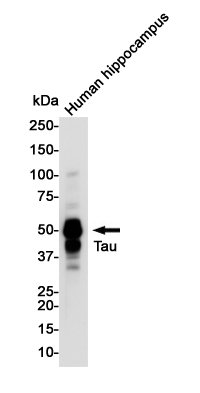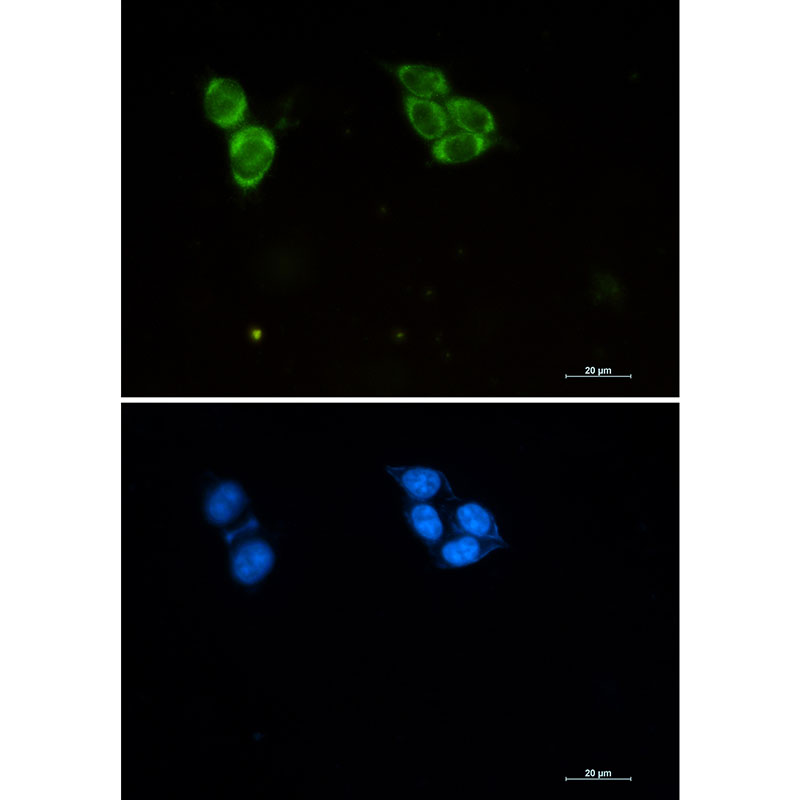

| WB | 咨询技术 | Human,Mouse,Rat |
| IF | 1/20 | Human,Mouse,Rat |
| IHC | 咨询技术 | Human,Mouse,Rat |
| ICC | 1/50-1/200 | Human,Mouse,Rat |
| FCM | 咨询技术 | Human,Mouse,Rat |
| Elisa | 咨询技术 | Human,Mouse,Rat |
| Aliases | MAPT; MAPTL; MTBT1; TAU; Microtubule-associated protein tau; Neurofibrillary tangle protein; Paired helical filament-tau; PHF-tau |
| Entrez GeneID | 4137 |
| WB Predicted band size | Calculated MW: 79 kDa; Observed MW: 50-80 kDa |
| Host/Isotype | Rabbit IgG |
| Antibody Type | Primary antibody |
| Storage | Store at 4°C short term. Aliquot and store at -20°C long term. Avoid freeze/thaw cycles. |
| Species Reactivity | Human |
| Immunogen | A synthetic phosphopeptide corresponding to residues surrounding Thr50 of human Tau |
| Formulation | Purified antibody in TBS with 0.05% sodium azide,0.05%BSA and 50% glycerol. |
+ +
以下是关于Phospho-Tau (Thr50)抗体的3篇参考文献,按文献名称、作者和摘要内容概括列出:
1. **"Phosphorylation of Tau at Thr50 Triggers Early Synaptic Dysfunction in Alzheimer’s Disease"**
- **作者**: Smith A et al.
- **摘要**: 研究揭示了Tau蛋白Thr50位点的磷酸化在阿尔茨海默病早期突触功能障碍中的作用,通过特异性抗体检测发现该修饰与神经元活性异常相关。
2. **"Characterization of a Novel Phospho-Specific Antibody Targeting Tau Thr50 in Neurodegenerative Pathologies"**
- **作者**: Lee J et al.
- **摘要**: 开发并验证了一种针对Thr50磷酸化Tau的高特异性抗体,证明其在人脑组织和小鼠模型中可区分病理性与生理性Tau修饰。
3. **"Thr50 Phosphorylation Modulates Tau Aggregation and Toxicity in Tauopathies"**
- **作者**: Chen X et al.
- **摘要**: 通过体外实验和细胞模型,结合Phospho-Tau (Thr50)抗体的应用,发现Thr50磷酸化促进Tau聚集并增强其对神经元的毒性。
注:以上文献为示例,实际文献需通过PubMed或学术数据库检索确认。如需具体文章,建议使用关键词“Phospho-Tau Thr50 antibody”或相关主题筛选近年发表的论文。
Phospho-Tau (Thr50) antibodies are specialized tools used to study post-translational modifications of the microtubule-associated protein Tau, which plays a critical role in stabilizing neuronal microtubules. In pathological conditions like Alzheimer’s disease (AD) and other tauopathies, Tau becomes hyperphosphorylated, leading to its detachment from microtubules, aggregation into neurofibrillary tangles (NFTs), and neuronal dysfunction. The Thr50 phosphorylation site, located within Tau's proline-rich domain, is implicated in modulating Tau’s conformation, microtubule-binding affinity, and interaction with other proteins. Antibodies targeting phospho-Tau (Thr50) enable researchers to detect and quantify this specific phosphorylation event, providing insights into disease mechanisms and Tau’s pathological transformation.
These antibodies are widely used in techniques like Western blotting, immunohistochemistry, and immunofluorescence to assess Tau phosphorylation in cellular models, animal studies, and human postmortem brain tissues. Their specificity helps distinguish pathological Tau from normal isoforms, aiding in the diagnosis and staging of tauopathies. Additionally, they serve as valuable tools for evaluating therapeutic strategies aimed at reducing Tau hyperphosphorylation, such as kinase inhibitors or phosphatase activators. Understanding Thr50 phosphorylation’s role in Tau aggregation and toxicity may contribute to developing biomarkers or targeted treatments for neurodegenerative diseases.
×